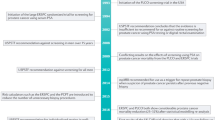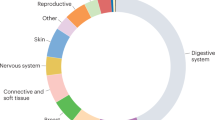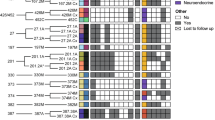Abstract
Prostate cancer is the most frequently diagnosed cancer in men. However, current diagnostic techniques (including serum PSA level measurement) lack sufficient specificity and sensitivity to determine the aggressiveness of the disease and to identify appropriate treatment. Additional reliable biomarkers are needed that can facilitate early diagnosis of prostate cancer, determine the patient's prognosis and predict responses to a given therapeutic intervention. To achieve clinical utility, biomarkers require the potential for commercialization, and such an investment is generally only made if a financial return is promised. Patenting is one way to protect the intellectual property surrounding such biomarkers and several patented biomarkers are being developed, although few have been validated in large-scale clinical trials.
This is a preview of subscription content, access via your institution
Access options
Subscribe to this journal
Receive 12 print issues and online access
$209.00 per year
only $17.42 per issue
Buy this article
- Purchase on Springer Link
- Instant access to full article PDF
Prices may be subject to local taxes which are calculated during checkout
Similar content being viewed by others
References
Biomarkers Definitions Working Group. Biomarkers and surrogate endpoints: preferred definitions and conceptual framework. Clin. Pharmacol. Ther. 69, 89–95 (2001).
Shariat, S. F. et al. Tumour markers in prostate cancer I: blood based markers. Acta. Oncol. 50 (Suppl. 1), 61–75 (2011).
Jackson, T. et al. Disclosure of diagnosis and treatment among early stage prostate cancer survivors. Patient Educ. Couns. 79, 239–244 (2010).
Cancer Facts & Figures 2009. American Cancer Society [online], (2009).
Lukes, M. et al. Prostate-specific antigen: current status. Folia Biol. (Praha) 47, 41–49 (2001).
Allhoff, E., de Riese, W., Eifinger, M., Pethke, J. & Jones, U. Prostate-specific antigen-comparative clinical appreciation of a serodiagnostic measure after 8 years of experience. World J. Urol. 7, 12–16 (1989).
Cooner, W. H. et al. Prostate cancer detection in a clinical urological practice by ultrasonography, digital rectal examination and prostate specific antigen. J. Urol. 143, 1146–1154 (1990).
Aly, M., Wiklund, F. & Grönberg, H. Early detection of prostate cancer with emphasis on genetic markers 1. Acta. Oncol. 50 (Suppl. 1), 18–23 (2011).
Wright, J. L. & Lange, P. H. Newer potential biomarkers in prostate cancer. Rev. Urol. 9, 207–213 (2007).
Thorpe, A. & Neal, D. Benign prostatic hyperplasia. Lancet 361, 1359–1367 (2003).
De Nunzio, C. et al. The controversial relationship between benign prostatic hyperplasia and prostate cancer: the role of inflammation. Eur. Urol. 60, 106–117 (2011).
Gulati, R. et al. What if I don't treat my PSA-detected prostate cancer? Answers from three natural history models. Cancer Epidemiol. Biomarkers Prev. 20, 740–750 (2011).
Auprich, M. et al. Contemporary role of prostate cancer antigen 3 in the management of prostate cancer. Eur. Urol. 60, 1045–1054 (2011).
Auprich, M. et al. Critical assessment of preoperative urinary prostate cancer antigen 3 on the accuracy of prostate cancer staging. Eur. Urol. 59, 96–105 (2011).
Oon, S. F., Pennington, S. R., Fitzpatrick, J. M. & Watson, R. W. Biomarker research in prostate cancer—towards utility, not futility. Nat. Rev. Urol. 8, 131–138 (2011).
Chodak, G. W., Keller, P. & Schoenberg, H. W. Assessment of screening for prostate cancer using the digital rectal examination. J. Urol. 141, 1136–1138 (1989).
Gosselaar, C., Kranse, R., Roobol, M. J., Roemeling, S. & Schröder, F. H. The interobserver variability of digital rectal examination in a large randomized trial for the screening of prostate cancer. Prostate 68, 985–993 (2008).
Vickers, A. J. et al. Impact of recent screening on predicting the outcome of prostate cancer biopsy in men with elevated PSA: data from the European Randomized Study of Prostate Cancer Screening in Gothenburg, Sweden. Cancer 116, 2612–2620 (2010).
You, J. et al. Innovative biomarkers for prostate cancer early diagnosis and progression. Crit. Rev. Oncol. Hematol. 73, 10–22 (2010).
Edge, S. B. et al. (eds) AJCC Cancer Staging Manual (Springer, New York, 2010).
Gleason, D. F. & Mellinger, G. T. Prediction of prognosis for prostatic adenocarcinoma by combined histological grading and clinical staging. J. Urol. 111, 58–64 (1974).
Schmidt, C. Gleason scoring system faces change and debate. J. Natl Cancer Inst. 101, 622–629 (2009).
Cheng, L., Montironi, R., Bostwick, D. G., Lopez-Beltran, A. & Berney, D. M. Staging of prostate cancer. Histopathology 60, 87–117 (2012).
Bostwick, D. G. et al. Prognostic factors in prostate cancer. College of American Pathologists Consensus Statement 1999. Arch. Pathol. Lab. Med. 124, 995–1000 (2000).
Shen, M. M. & Abate-Shen, C. Molecular genetics of prostate cancer: new prospects for old challenges. Genes Dev. 24, 1967–2000 (2010).
Porkka, K. P. & Visakorpi, T. Molecular mechanisms of prostate cancer. Eur. Urol. 45, 683–691 (2004).
Reynolds, M. A. Molecular alterations in prostate cancer. Cancer Lett. 271, 13–24 (2008).
Ho, C. M. & Weilbaecher, A. Patents versus patients: must we choose? Ann. Health Law 18, i–xv (2009).
Mejer, M. & van Pottelsberghe de la Potterie, B. Patent backlogs at USPTO and EPO: systemic failure vs deliberate delays. World Patent Inf. 33, 122–127 (2011).
Sternitzke, C. Reducing uncertainty in the patent application procedure—insights from invalidating prior art in European patent applications. World Patent Inf. 31, 48–53 (2009).
Madu, C. O. & Lu, Y. Novel diagnostic biomarkers for prostate cancer. J. Cancer 1, 150–177 (2010).
Busse, U., Chypre, C. & Fradet, Y. PCA3 messenger RNA species in benign and malignant prostate tissues. US Patent 7,368,545 (2010).
Daly, J. R., Jost, M., Reynolds, M. A., Groskopf, J. & Rittenhouse, H. PCA3: from basic molecular science to the clinical lab. Cancer Lett. 301, 1–6 (2011).
PROGENSA®PCA3 featured at European Association of Urology congress in Paris. DiagnoCure [online], (2012).
Pettersson, K., Lilja, H., Lövgren, T. & Niemelä, P. Antibody, immunoassay and method for prostate cancer detection. US Patent 7,872,104 (2001).
Vickers, A. J. et al. A panel of kallikrein markers can reduce unnecessary biopsy for prostate cancer: data from the European Randomized Study of Prostate Cancer Screening in Göteborg, Sweden. BMC Med. 6, 19–29 (2008).
Hessels, D., Verhaegh, G., Schalken, J. A. & Witjes, A. J. mRNA ratios in urinary sediments and/or urine as a prognostic and/or theranostic marker for prostate cancer. US Patent 7,960,109 (2005).
Zhang, Z., Barnhill, S. D., Madyastha, R. & Zhang, H. Methods for diagnosing cancer by measuring creatine kinase. US Patent 6,309,816 (1998).
Tewari, P. Detection of PSA-.α.2-macroglobulin complex in a biological fluid. US Patent 6,548,260 (1998).
Griffiths, K. & Turkes, A. T. Detection of prostate cancer measuring PSA/IGF-1 ratio. European Patent 1,218,749 (2000).
Duan, X., Kim, N. & Wolfert, R. L. Cln101 antibody compositions and methods of use alone and in combination with prostate specific antigen and other cancer markers. US Patent 7,560,531 (2004).
Stearns, M., Hu, Y. & Wang, M. Prostate cancer-related compositions, methods and kits based on DNA macroarray proteomics platforms. US Patent 7,939,274 (2010).
Saatcioglu, F. Prostate-specific or testis-specific nucleic acid molecules, polypeptides, and diagnostic and therapeutic methods. US Patent 7,611,892 (2006).
Sidransky, D. Method of detection of prostate cancer. US Patent 7,524,633 (2007).
Jerónimo, C. et al. Quantitation of GSTP1 methylation in non-neoplastic prostatic tissue and organ-confined prostate adenocarcinoma. J. Natl Cancer Inst. 93, 1747–1752 (2001).
Tsujikawa, K., Yamamoto, H. & Konishi, N. Method for diagnosis of prostate cancer. European Patent 1,862,804 (2006).
Castellani, L. W. et al. Apolipoprotein AII is a regulator of very low density lipoprotein metabolism and insulin resistance. J. Biol. Chem. 283, 11633–11644 (2008).
Semmes, J. O., Malik, G. & Ward, M. D. Apolipoprotein A-II isoform as a biomarker for prostate cancer. European Patent 1,838,867 (2006).
An, G. & Veltri, R. Prostate-specific gene for diagnosis, prognosis and management of prostate cancer. US Patent 7,993,830 (2007).
Thompson, T. C. Methods and compositions for diagnosis and monitoring of prostate cancer progression by detection of serum caveolin. US Patent 7,462,491 (2004).
Golub, T. R., Febbo, P. G., Ross, K. N. & Sellers, W. R. Prostate cancer diagnosis and outcome prediction by expression analysis. US Patent 7,501,248 (2005).
Penny, K. L. et al. mRNA expression signature of gleason grade predicts lethal prostate cancer. J. Clin. Oncol. 29, 2391–2396 (2011).
Tempst, P. & Villanueva, J. Methods of detection of cancer using peptide profiles. US Patent 7,972,770 (2006).
Mikolajczyk, S. D., Wang, T. J., Rittenhouse, H. G., Wolfert, R. L. & Slawin, K. Forms of prostate specific antigen (PSA) specific for benign prostatic hyperplasia (BPH) and methods of using such. US Patent 6,482,599 (1999).
Amano, J., Hirano, K. & Sugimoto, I. Method of distinguishing prostate cancer from benign prostatic hypertrophy. US Patent 8,030,085 (2008).
Chudin, E., Lozach, J., Fan, J. & Bibikova, M. Gene expression profiles to predict relapse of prostate cancer. US Patent 7,914,988 (2007).
Keller, E. T. & Fu, Z. Systems and methods for detecting and regulating metastasis. US Patent 7,407,763 (2005).
Bao, L. & Wang, D. G. Pin 1 as a marker for prostate cancer. US Patent 7,592,145 (2006).
Siegler, K. M. Serum macrophage migration inhibitory factor (MIF) as marker for prostate cancer. US Patent 7,361,474 (2003).
Reed, J. C. & Krajewske, S. Methods for determining the prognosis for patients with a prostate neoplastic condition using inhibitor of apoptosis polypeptides. US Patent 7,704,700 (2003).
O'Riordan, M. X. D., Bauler, L. D., Scott, F. L. & Duckett, C. S. Inhibitor of apoptosis (IAP) proteins in eukaryotic evolution and development: a model of thematic conservation. Dev. Cell 15, 497–508 (2008).
Rubin, M. A. & DeMichelis, F. Biomarkers for predicting prostate cancer progression. US Patent 7,803,552 (2009).
Glinsky, G. V., Glinskii, A. B., Stephenson, A. J., Hoffman, R. M. & Gerald, W. L. Gene expression profiling predicts clinical outcome of prostate cancer. J. Clin. Invest. 113, 913–923 (2004).
Li, C. & Wong, W. H. Model-based analysis of oligonucleotide arrays: expression index computation and outlier detection. Proc. Natl Acad. Sci. USA 98, 31–36 (2001).
Wang, D., Herzenberg, L. A., Peehl, D. M. & Herzenberg, L. A. Prostate cancer glycan markers and autoantibody signatures. US Patent 7,981,625 (2009).
Neagu, M., Constantin, C., Tanase, C. & Boda, D. Patented biomarker panels in early detection of cancer. Recent Pat. Biomark. 1, 10–24 (2011).
US Department of Heath and Human Services, FDA, Center for Drug Evaluation and Research, Center for Biologics Evaluation and Research & Center for Devices and Radiological Health. Guidance for industry: pharmacogenomic data dubmissions [online], (2005).
European Medicines Agency. Guideline on the validation of bioanalytical methods [online], (2011).
US Department of Heath and Human Services, FDA, Center for Drug Evaluation and Research & Center for Veterinary Medicine. Guidance for industry: bioanalytical method validation [online], (2001).
Valentin, M. A., Ma, S., Zhao, A., Legay, F. O. & Avrameas, A. Validation of immunoassay for protein biomarkers: bioanalytical study plan implementation to support pre-clinical and clinical studies. J. Pharm. Biomed. Anal. 55, 869–877 (2011).
Swanson, G. P., Yu, C., Kattan, M. W. & Hermans, M. R. Validation of postoperative nomograms in prostate cancer patients with long-term follow-up. Urology 78, 105–109 (2011).
Specht, M. C., Kattan, M. W., Gonen, M., Fey, J. & Van Zee, K. J. Predicting nonsentinel node status after positive sentinel lymph biopsy for breast cancer: clinicians versus nomogram. Ann. Surg. Oncol. 12, 654–659 (2005).
Vickers, A. J. Prediction models in cancer care. CA Cancer J. Clin. 61, 315–326, (2011).
Garofolo, F., Smeraglia, J., Briggs, R., Seymour, M. & Hill, H. Conference report: discussion on harmonization and globalization of bioanalytical guidances at the 19th International Reid Bioanalytical Forum. Bioanalysis 3, 2717–2720 (2011).
US Department of Heath and Human Services, FDA, Center for Drug Evaluation and Research & Center for Biologics Evaluation and Research. Guidance for industry: clinical trial endpoints for the approval of cancer drugs and biologics [online], (2007).
Chowdhury, F., Williams, A. & Johnson, P. Validation and comparison of two multiplex technologies, Luminex and Mesoscale Discovery, for human cytokine profiling. J. Immunol. Methods 340, 55–64 (2009).
Kruse, N., Schulz-Schaeffer, W. J., Schlossmacher, M. G. & Mollenhauer, B. Development of electrochemiluminescence-based singleplex and multiplex assays for the quantification of α-synuclein and other proteins in cerebrospinal fluid. Methods http://dx.doi.org/10.1016/j.ymeth.2012.03.016
Semenuk, M. A. et al. Translating cancer biomarker discoveries to clinical tests: what should be considered? Recent Pat. Biomark. 1, 222–240 (2011).
Schröder, F. H. et al. Screening and prostate-cancer mortality in a randomized European study. N. Engl. J. Med. 26, 1320–1328 (2009).
Stephenson, A. J. et al. Defining biochemical recurrence of prostate cancer after radical prostatectomy: a proposal for a standardized definition. J. Clin. Oncol. 24, 3973–3978 (2006).
Lilja, H., Ulmert, D. & Vickers, A. J. Prostate-specific antigen and prostate cancer: prediction, detection and monitoring. Nat. Rev. Cancer 8, 268–278 (2008).
Horwitz, E. M. et al. Definitions of biochemical failure that best predict clinical failure in patients with prostate cancer treated with external beam radiation alone: a multi-institutional pooled analysis. J. Urol. 173, 797–802 (2005).
Acknowledgements
The authors are supported by the Health Research Board (HRB) as part of the HRB–Science Foundation Ireland translational research award (TRA/2010/18).
Author information
Authors and Affiliations
Contributions
L. Murphy researched the data for this article. Both authors wrote and edited the manuscript before submission as well as contributing to the discussion of its content.
Corresponding author
Ethics declarations
Competing interests
The authors declare no competing financial interests.
Rights and permissions
About this article
Cite this article
Murphy, L., Watson, R. Patented prostate cancer biomarkers. Nat Rev Urol 9, 464–472 (2012). https://doi.org/10.1038/nrurol.2012.130
Published:
Issue Date:
DOI: https://doi.org/10.1038/nrurol.2012.130



